Don’t go jumping waterfalls
“Waterfalls” by Paul McCartney
Please keep to the lake
People who jump waterfalls
Sometimes can make mistakes
Tragically, people die every year at North Carolina waterfalls and countless others suffer injuries. None of these people thought they were going to get hurt. Some had no clue they were doing anything dangerous. Some thought they had the necessary skills and experience to prevent anything bad from happening to them.
People say that waterfalls are dangerous, but there’s nothing inherently hazardous about them. A waterfall doesn’t reach out and grab people and fling them over the top. The reason people get hurt at waterfalls is because they put themselves in dangerous situations. Nearly all waterfall accidents could be avoided by understanding the potential dangers and taking them seriously.
Accidents often occur in remote and hard-to-reach locations. As Kimberly Bailey, with Transylvania County EMS cautions, “this leads to lengthier response times for rescue personnel who sometimes put themselves in harm’s way for the rescue effort.” If you get hurt, you could jeopardize others. Numerous rescue operations in western North Carolina have led to the deaths and injuries of first responders.
David Casey, with Pisgah National Forest, sums up safety advice by stating that we should all “have situational awareness.” In other words, slow down, look around, pay attention, think!
Often, accidents occur because people don’t fully realize the hazards. Please read and FOLLOW these safety practices. Safety is not just something you read about; it’s something you do.
A waterfall doesn’t care if you have a loved one waiting at home.
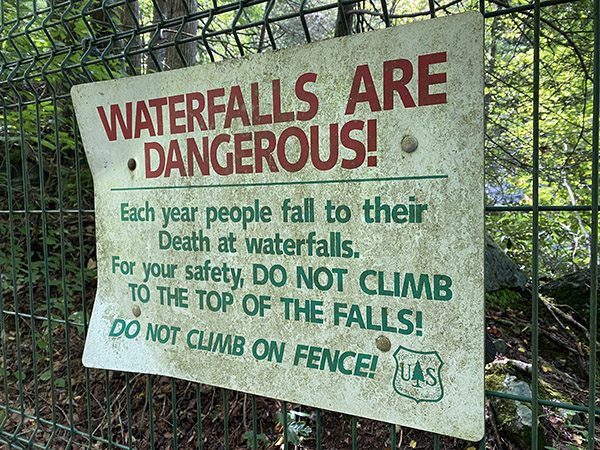
Stay on safe ground
Never climb waterfalls or go anywhere near the top. The waterfall atmosphere can cause even experienced hikers to lose full control of their senses and fall. Some people think a rope will protect them, but this can create a false sense of security that leads to disaster. You must have the right kind of rope and safety harness and have the proper training in how to use them.
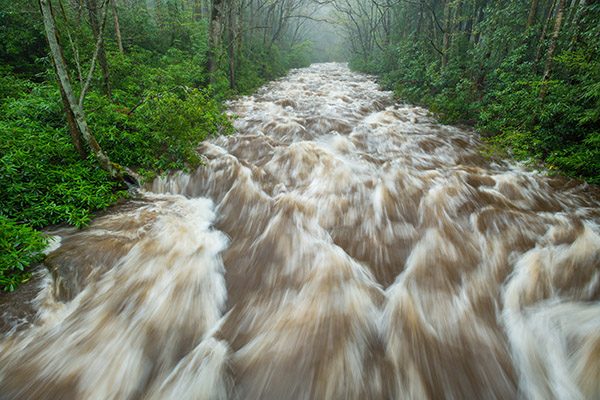
Stay in safe water
Everyone likes to play in the water, but you should be extremely careful in the waterfall environment. Never jump into plunge pools. Logs or rocks may be hidden under the surface, and the sudden impact of the extremely cold water can cause temporary paralysis that could lead to drowning. Don’t swim anywhere near where the waterfall hits the plunge pool. Churning currents called hydraulics can trap you under water. River currents everywhere are stronger than you may realize. Never enter the water anywhere near the top of a waterfall. Be extremely careful when crossing streams if the water is more than a few inches deep.
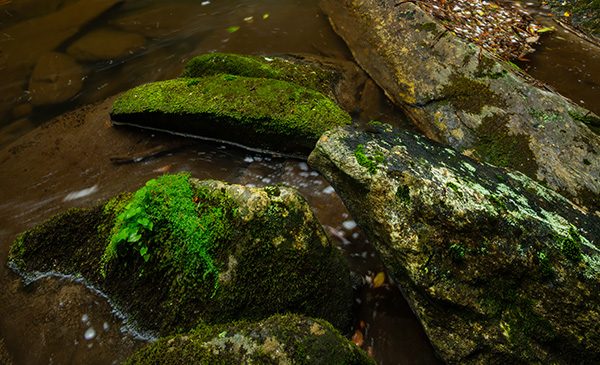
Stay off slick surfaces
Rocks at waterfalls and in streams can be extremely slippery, especially wet ones. No shoe will provide a sure grip if the rocks are covered in silt or algae.
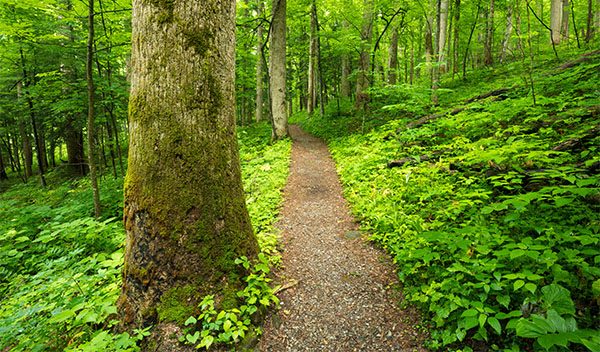
Stay on the trail
The moment you leave the trail, the chances for getting hurt or becoming lost increase significantly. If you do hike off trail, you should go slowly, watch every step, and wear ankle-supporting shoes. The next step you take could be on a leaf-covered rock that falls out under your foot and causes a fall. In addition to the safety issues, hiking off trail introduces the likelihood of trampling vegetation.

Protect your feet
Flip flops are dangerous. They provide no protection and can cause falls or twisted ankles from walking on uneven terrain. Sandals are fine for wading in the pool, but they don’t provide adequate protection for hiking on most trails. Sneakers are okay for hiking on graded trails, but if you have weak ankles you shouldn’t wear them on rocky or rooty trails. The best foot protection comes from hiking shoes that provide full ankle support.
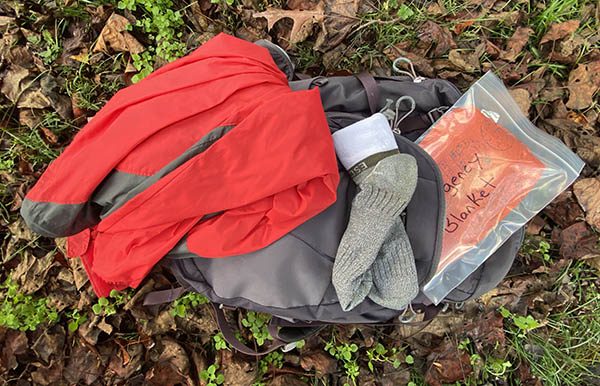
Be comfortable
Bring rain gear and extra clothing. If you accidently fall in the creek you could become hypothermic, even in mild weather. Rain gear is a necessity for any hike that isn’t close to the road. Mountain weather can change quickly. It’s a good idea to pack an extra pair of socks in case your feet get wet. It’s also a good idea to pack an emergency blanket, even for a day hike. If you get wet, you could quickly become chilled. Wrapping up in an emergency blanket while you’re hiking back could prevent you from becoming hypothermic.

Don’t count on your phone
Phone service is very limited at many North Carolina waterfalls. If you’re in trouble, it could be hours before help arrives. Tell someone where you’re going and when you expect to be back.

Watch the wind
Avoid hiking in western North Carolina on very windy days. Countless eastern hemlock skeletons remain standing after dying from the hemlock woolly adelgid infestation. These trees can fall at any time, but especially on windy days.
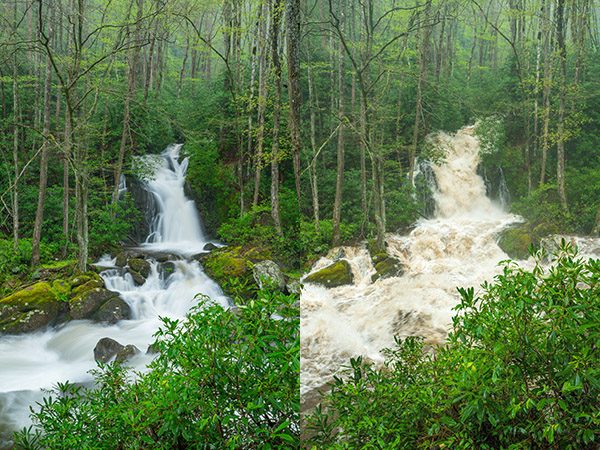
Watch the rain
Flash flooding can occur, but heavy rains cause other safety issues that you may not think about. That stream you crossed easily on the hike to the waterfall may be impassible on the way back, leaving you stranded. Landslides are another concern. You should avoid hiking trails along steep slopes during heavy rains when the soil is saturated.
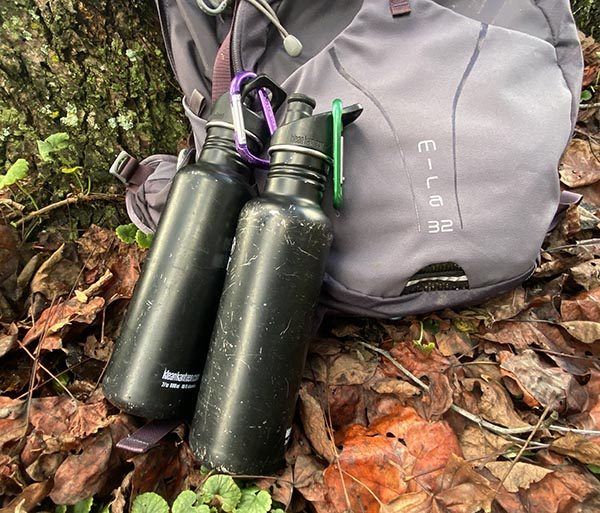
Stay hydrated
Bring plenty of water and drink before you get thirsty. Do not drink water from streams unless you filter or purify it.
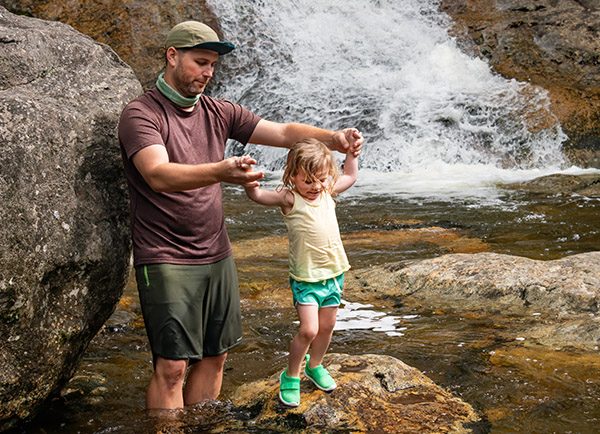
Watch the kids
Don’t let children run around unsupervised. They don’t understand how to be safe and if they get themselves into an unsafe situation, you could also do something unsafe in the rush to protect them.
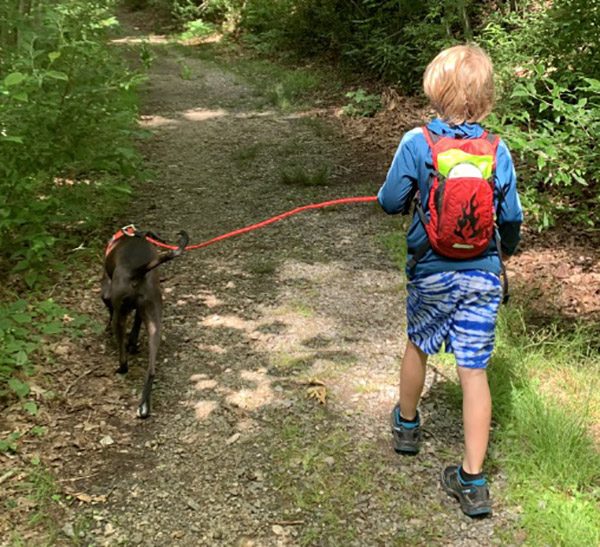
Keep the dogs on a leash
It’s hard not to let Spot play in the water off leash, but remember that a dog has no concept of waterfall safety. They can easily slip on rocks, climb dangerously, and underestimate the strength of currents. You could also be hurt in your efforts to rescue them.
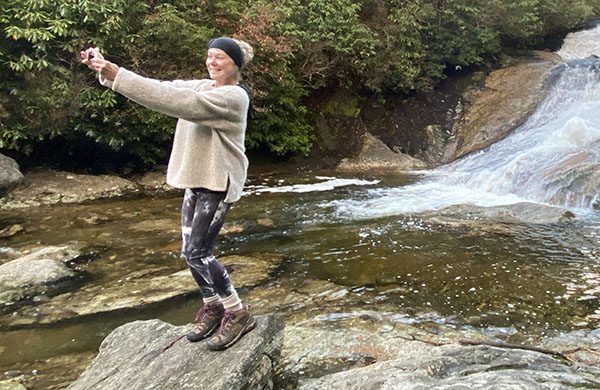
Watch the selfies
An alarming number of people die each year while taking selfies and not paying attention to where they’re standing. Before you take the shot, find a safe place to pose and then don’t move again while you’re looking at your phone. If you need a better angle, lower the phone and watch where you’re stepping.
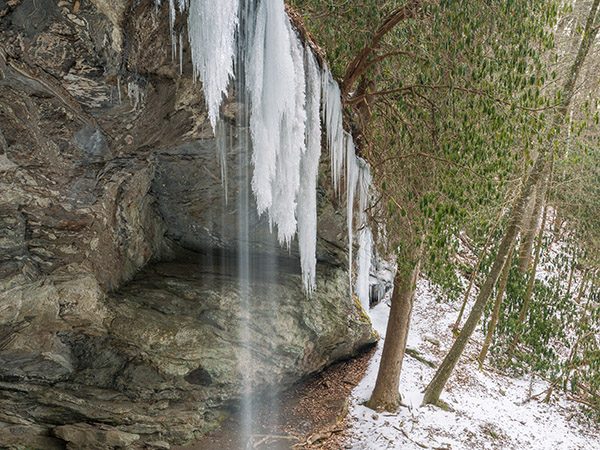
Be extra careful in winter
Freezing temperatures create especially dangerous situations at waterfalls. Waterfall spray freezes on everything it touches, including the ground and rocks you want to walk on. You should wear crampons or ice cleats anytime you walk on ice. Icicles at waterfalls can be deadly when they fall, as they often do. Never stand under an icicle.

Avoid alcohol and marijuana
Don’t do anything that can impair your judgement in the slightest. Even a single drink could dull your senses and cause a mishap.
What’s out to get you?

Bears
A negative encounter with a bear in North Carolina is extremely unlikely. If you use common sense and leave bears alone, they’ll leave you alone. Don’t throw food at them, and don’t run from them. If a bear acts aggressive, stand your ground and raise your hands slightly to give the impression that you’re bigger. Shout or throw rocks if necessary. If a black bear charges, it’s most likely a bluff. It’s hard to stand your ground against a charging bear, but that’s what the experts say to do. If you absolutely must, throw your pack or lunch sack at the bear to give yourself an opportunity to escape. Do this only as a last result, though, since this only encourages bears to become aggressive. Finally, the experts say that if a black bear does make contact and continues attacking, don’t play dead. That works only with grizzlies. If a black bear continues an attack, it might consider you a food source. In that case, you should fight back as aggressively as you can.

Snakes
There are only two venomous snakes you are likely to encounter while hiking to a North Carolina waterfall, the copperhead and timber rattlesnake. Neither snake is aggressive, so if you just leave them alone, they’ll return the favor. Be careful not to sneak up on a snake by doing things like stepping over a log without checking the other side, or sticking your hands in a crevice without looking in it first. Pay attention to where you put your feet and hands and you’ll be fine.

Stinging insects
Yellow jackets nests are common in North Carolina and if you spend much time hiking to waterfalls, you’re likely to encounter one. Obviously, if you see insects buzzing around, you should move quickly through the area. If you’re hiking with friends, keep in mind that often the first person of the group stirs up the yellow jackets without even knowing it, while the second gets the most stings. So if you aren’t in the lead, you should pay extra attention. Yellow jackets are active from June through September, with August and September being the most active months.
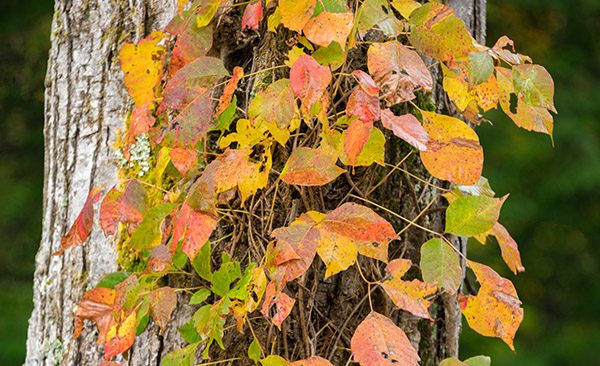
Poison ivy
Poison ivy is abundant all over North Carolina and grows along many trails to waterfalls, especially in more open and dry areas. Any part of the forest having some sort of human disturbance is likely to be home to poison ivy. The best medicine is preventive. Learn to identify it before you hike and just stay out of the stuff.

Wood Nettle
You might not know about this menace, but if you brush up against it while wearing shorts, you’ll quickly learn. Examine a nettle plant closely and you’ll see thousands of tiny prickles all over the leaves and stem. They sting like fire when you brush against them, although fortunately the sting doesn’t last long. Nettle is so common in the areas you hike through to visit waterfalls that it’s about impossible to avoid touching it. It’s best to wear long pants from early summer to fall. Wood nettle is commonly called stinging nettle. Stinging nettle, Urtica dioica, is more common to the north. Wood nettle, Laportea canadensis, is the nettle you’re likely to encounter in North Carolina.

Bad Water
Don’t consider any backcountry water as safe to drink, no matter how clear or pure it appears. Numerous bacteria and viruses are present in streams, and some, like Giardia lamblia, can make life miserable. Even spring water isn’t reliably safe to drink without treatment. Take water with you, or carry a filtering device or purifier.
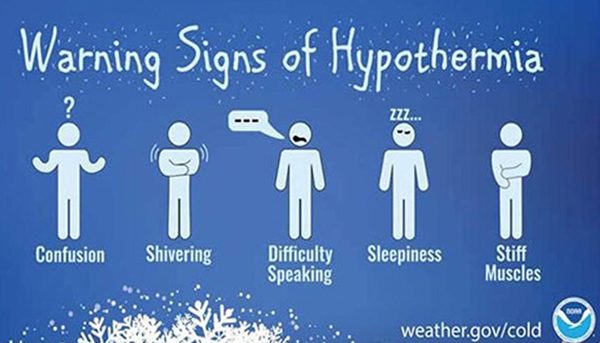
Hypothermia
Hypothermia, the lowering of the body’s core temperature to the point that organs can’t function properly, is serious business. Symptoms include uncontrolled shivering and slurred speech. A number of factors contribute, but cool air, wetness, and wind are the main causes. Being dehydrated or hungry makes it worse. You might think this can’t happen to you, but that kind of thinking makes you a prime candidate because you’re not taking matters seriously. You could get into trouble before you realize it.
Hypothermia is most likely to occur on long or overnight hikes. Photographers especially put themselves into situations that increase the danger. They often remain still for long periods of time, sometimes even standing in cold water, and can get so caught up in “getting the shot” that they don’t pay attention to physical discomfort.
If you hike alone, pay attention to your physical condition at all times. At the slightest hint of discomfort from cold—shivering, sluggishness, a slow mind—stop whatever you’re doing and make your body comfortable. Eat and drink lots of water. Don’t wait. A nasty symptom of advanced hypothermia is a sense of being too warm. Hypothermic victims often strip off their clothing because they think they are too hot, when in reality they are freezing to death.
Hypothermia can happen during surprisingly warm temperatures. In winter, hikers usually go out more prepared for the cold, with hats and gloves and extra clothing. In spring and fall, it’s easier to be caught off guard, especially if it rains or if you get drenched by waterfall spray.



